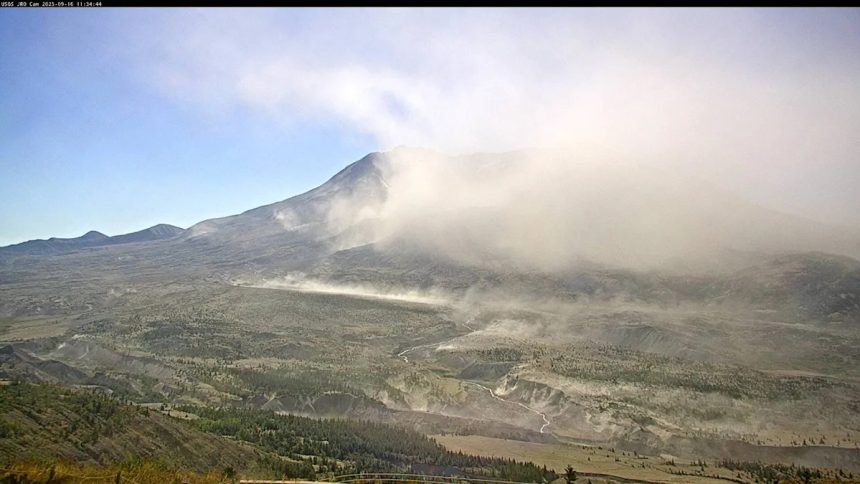Don’t panic: Mount St. Helens is not erupting.
Officials confirmed on Sept. 16 that Mount St. Helens does have ash surrounding it after commercial pilots reported seeing ash near the mountain, famous for its catastrophic May 18, 1980, eruption that killed 57 people.
So what’s going on?
“Volcanic ash from the 1980s is being lofted back into the air from the strong east winds,” the National Weather Service in Portland, Oregon, reported.
Is Mount St. Helens erupting?
There is no ongoing eruption.
According to a statement from the U.S. Geological Survey, “strong easterly–southeasterly winds in the vicinity of Mount St. Helens have picked up loose volcanic ash deposited during the 1980 eruptions and are carrying it to the west–northwest. The resuspended ash has been reported by commercial pilots in the area.”
“This phenomenon is not the result of recent volcanic activity and occasionally occurs during times of high winds and dry, snow-free conditions in the Mount St. Helens area. No eruption is in progress and Mount St. Helens remains at Aviation Color Code GREEN and Alert Level NORMAL.”
“Resuspended volcanic ash should be considered hazardous and could be damaging to aircraft and health,” the U.S. Geological Survey said.
File photo showing the eruption of Mount St. Helens on May 18, 1980.
When did Mount St. Helens erupt?
On May 18, 1980, the United States experienced the deadliest and most destructive volcanic eruption in its history. After more than two months of rumbling, Washington state’s Mount St. Helens erupted with a force equivalent to as much as 50 megatons of TNT.
More: The day the sky darkened: Mount St. Helens erupted in Washington State 45 years ago
The massive blast and subsequent landslides, flooding and ash cloud killed 57 people, caused more than $1 billion in damage and destroyed at least 200 homes, and was heard more than 200 miles away.
The resulting scorching ash cloud reached as high as 16 miles into the atmosphere, darkening the sky and causing homes and businesses as far as 300 miles away to close. A massive wave of melted snow, ice, ash and pumice raced down the sides of the mountain, reaching up to 60 miles away and crushing homes, forests, bridges, and roadways in its path.
Mount St. Helens live cam
Note: This is not a real-time feed. This is scheduled to update every 30 minutes to show the latest photo.

Mount St. Helens Webcam
When is the last time Mount St. Helens erupted?
Mount St. Helens, in Washington State, experienced its most recent significant eruptive phase between October 2004 and January 2008. This activity was primarily characterized by the extrusion of lava within the crater, forming a new lava dome.
The eruption was largely non-explosive. The first notable explosion occurred on Jan. 16, 2005, during a winter storm, and was one of only two significant explosions during this period. Ash from these events temporarily disrupted monitoring instruments in the crater, according to the U.S. Geological Survey.
The lava dome grew gradually, with new lava added at a slow, steady pace — eventually building taller than the Empire State Building. By late January 2008, the eruption had ceased, and the U.S. Geological Survey officially declared the eruption on July 10, 2008, marking the end of over three years of continuous volcanic activity.
Is Mount St. Helens still active?
Mount St. Helens is the most active volcano in the contiguous U.S., according to the U.S. Geological Survey. However, it currently displays only background seismic activity.
Air quality map in Washington
Washington weather watches and warnings
Stay informed. Get weather alerts via text
Contributing: Beth Weise
This article originally appeared on Kitsap Sun: Mt. St. Helens cam shows ash in Washington. Here’s why









